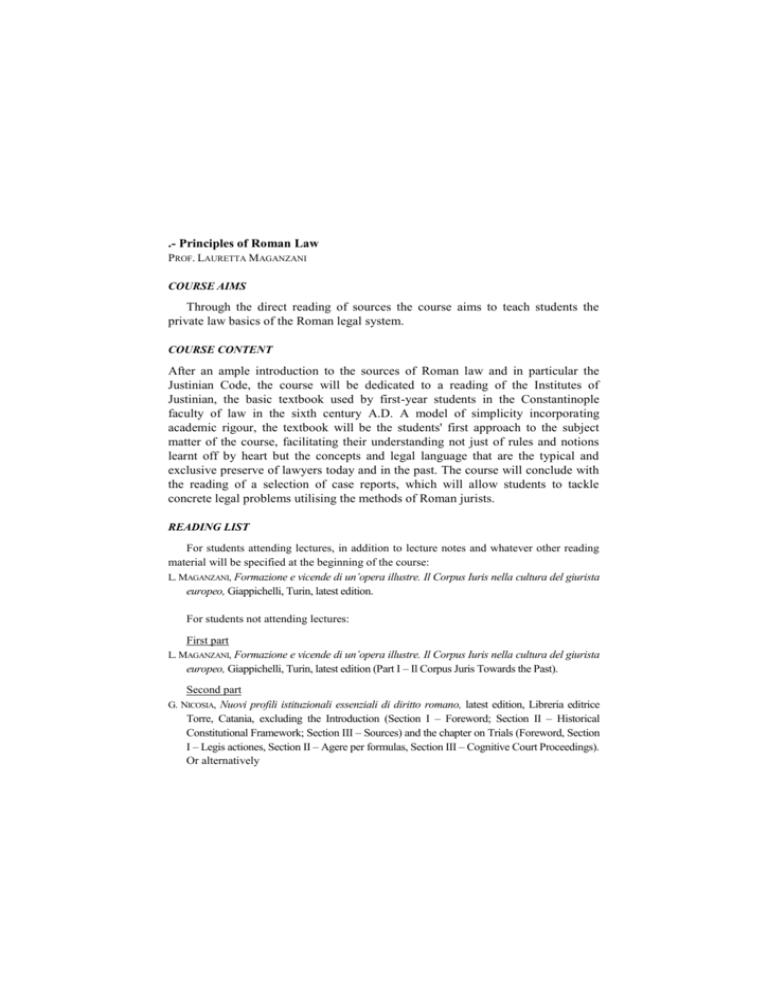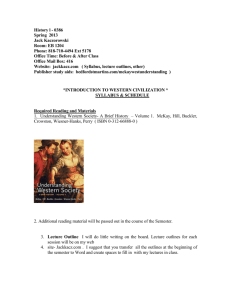Principles of Roman Law
advertisement

.- Principles of Roman Law PROF. LAURETTA MAGANZANI COURSE AIMS Through the direct reading of sources the course aims to teach students the private law basics of the Roman legal system. COURSE CONTENT After an ample introduction to the sources of Roman law and in particular the Justinian Code, the course will be dedicated to a reading of the Institutes of Justinian, the basic textbook used by first-year students in the Constantinople faculty of law in the sixth century A.D. A model of simplicity incorporating academic rigour, the textbook will be the students' first approach to the subject matter of the course, facilitating their understanding not just of rules and notions learnt off by heart but the concepts and legal language that are the typical and exclusive preserve of lawyers today and in the past. The course will conclude with the reading of a selection of case reports, which will allow students to tackle concrete legal problems utilising the methods of Roman jurists. READING LIST For students attending lectures, in addition to lecture notes and whatever other reading material will be specified at the beginning of the course: L. MAGANZANI, Formazione e vicende di un’opera illustre. Il Corpus Iuris nella cultura del giurista europeo, Giappichelli, Turin, latest edition. For students not attending lectures: First part L. MAGANZANI, Formazione e vicende di un’opera illustre. Il Corpus Iuris nella cultura del giurista europeo, Giappichelli, Turin, latest edition (Part I – Il Corpus Juris Towards the Past). Second part G. NICOSIA, Nuovi profili istituzionali essenziali di diritto romano, latest edition, Libreria editrice Torre, Catania, excluding the Introduction (Section I – Foreword; Section II – Historical Constitutional Framework; Section III – Sources) and the chapter on Trials (Foreword, Section I – Legis actiones, Section II – Agere per formulas, Section III – Cognitive Court Proceedings). Or alternatively A.D. MANFREDINI, Istituzioni di diritto romano, latest edition, Turin, Giappichelli, excluding the Introduction, Chapter I (Why We Study Roman Law, the Justinian Code), Chapter II (Periods and Sources) and all of Part III (Actions, Chapter I – Basic Concepts on Trials; Chapter II – Legal Actions; Chapter III – Agere per formulas; Chapter IV – Extraordinary Cognitive Court Proceedings). TEACHING METHOD Lectures and group seminars. ASSESSMENT METHOD For students attending lectures, interim oral test and final examination allied to continuous assessment. For students not attending lectures, oral examination. NOTES Further information can be found on the Faculty notice board. .- History of Law PROF. LAURETTA MAGANZANI – PROF. STEFANO SOLIMANO First Part: Principles of Roman Law PROF. LAURETTA MAGANZANI COURSE AIMS The course is designed to give students a solid grounding in private Roman law. COURSE CONTENT Study of the sources of Roman law and particular the Corpus Juris Civilis. Specific links between the structure and characteristics of the various historical components of the constituent Digest, Institutes and Code will be examined as regards their special features and from the unifying standpoint of Justinian. READING LIST L. MAGANZANI, Formazione e vicende di un’opera illustre. Il Corpus Iuris nella cultura del giurista europeo, Giappichelli, Turin, latest edition, pages 3-143. Further reading material may be specified at lectures. TEACHING METHOD Lectures and group seminars. ASSESSMENT METHOD For students attending lectures there is an interim oral exam, a final written exam and continuous assessment. For students not attending lectures there is a final oral exam. NOTES Further information can be found on the Faculty notice board.








